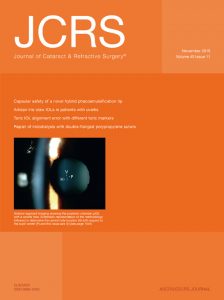Thomas Kohnen
Published: Wednesday, December 4, 2019
Upright phaco surgery
A new slit-lamp-based technique allows phacoemulsification surgery to be performed on patients who until now had been refused for cataract surgery. The new technique enabled surgeons to perform phacoemulsification on four eyes of two patients, who were sitting in a strictly upright position, by using a slit lamp rather than an operating microscope. The surgeon sits on the other side of the slit lamp, facing the patient, and operates via a temporal corneal incision. Both patients achieved a corrected distance visual acuity of 20/20 in both eyes. This approach could prove useful in patients unable to lie flat, including those with orthopnea, spinal deformity or Ménière's disease.
M Muraine et al., “Face-to-face phacoemulsification using a slit lamp in patients who are unable to lie flat”, Volume 45, #11, 1535-38.
Long-term ICL results
Phakic IOL implantation offers a treatment option for high myopia that preserves accommodation and spares the cornea. The implantable collamer lens (ICL, STAAR Surgical) is a posterior chamber pIOL that first appeared in 1993. The V4 model of the ICL was introduced in 1998 to address some issues encountered with the original version. Little is known about the long-term visual outcomes and anatomic effects of the V4 ICL. A new retrospective study of 110 eyes of 60 patients showed that the lens provided long-term stability and good refractive outcomes at the 10-year mark. Mean spherical equivalent was -0.65 ± 1.09D 10 years postoperatively. The mean vault height was 562.4 ± 175.9μm six months postoperatively, decreasing to 352.9 ± 171.8μm at 10 years. Lens opacities developed in 21 eyes (12.1%) during the 10-year follow-up. The mean vault in the lens opacity group was significantly lower than in the clear lens group after four years. No patient who had ICL implantation when they were 30 years or younger developed lens opacity or required phacoemulsification. The study found no significant decrease in endothelial cell density or increase in intraocular pressure over time.
JH Choi et al., “Ten-year clinical outcomes after implantation of a posterior chamber phakic intraocular lens for myopia”, Volume 45, #11, 1555-61.
Comparing defocus curves
Researchers evaluated the defocus curves of four presbyopia-correcting IOLs in a prospective clinical study. The four IOLs provided equally good corrected distance visual acuity (VA). The EDOF IOL yielded slightly better distance-corrected intermediate VA, but provided worse distance-corrected near VA than the other IOLs. That finding was clinically relevant, and a lower percentage of patients in the EDOF group achieved spectacle independence. Only the panfocal IOL gave better distance corrected intermediate VA at 50cm.
M Böhm et al., “Defocus curves of 4 presbyopia-correcting IOL designs: Diffractive panfocal, diffractive trifocal, segmental refractive, and extended-depth-of-focus”, Volume 45, #11, 1625-36.
Tags: edof iols, implantable collamer lens, phacoemulsification
Latest Articles
Nutrition and the Eye: A Recipe for Success
A look at the evidence for tasty ways of lowering risks and improving ocular health.
Read more...
New Award to Encourage Research into Sustainable Practices
Read more...
Sharing a Vision for the Future
ESCRS leaders update Trieste conference on ESCRS initiatives.
Read more...
Extending Depth of Satisfaction
The ESCRS Eye Journal Club discuss a new study reviewing the causes and management of dissatisfaction after implantation of an EDOF IOL.
Read more...
Conventional Versus Laser-Assisted Cataract Surgery
Evidence favours conventional technique in most cases.
Read more...
AI Scribing and Telephone Management
Automating note-taking and call centres could boost practice efficiency.
Read more...
AI Analysis and the Cornea
A combination of better imaging and AI deep learning could significantly improve corneal imaging and diagnosis.
Read more...
Cooking a Feast for the Eyes
A cookbook to promote ocular health through thoughtful and traditional cuisine.
Read more...
Need to Know: Spherical Aberration
Part three of this series examines spherical aberration and its influence on higher-order aberrations.
Read more...
Generating AI’s Potential
How generative AI impacts medicine, society, and the environment.
Read more...

